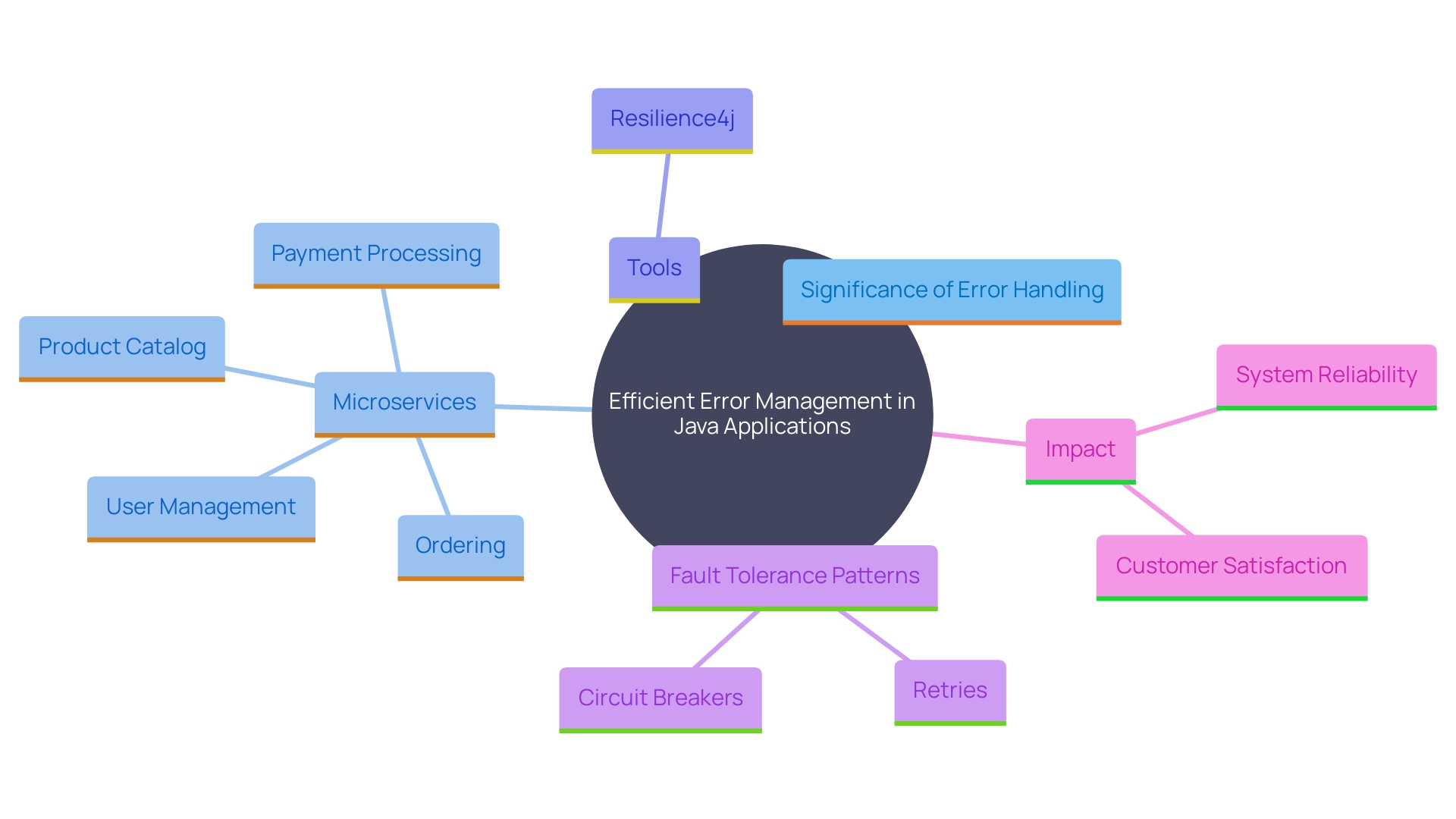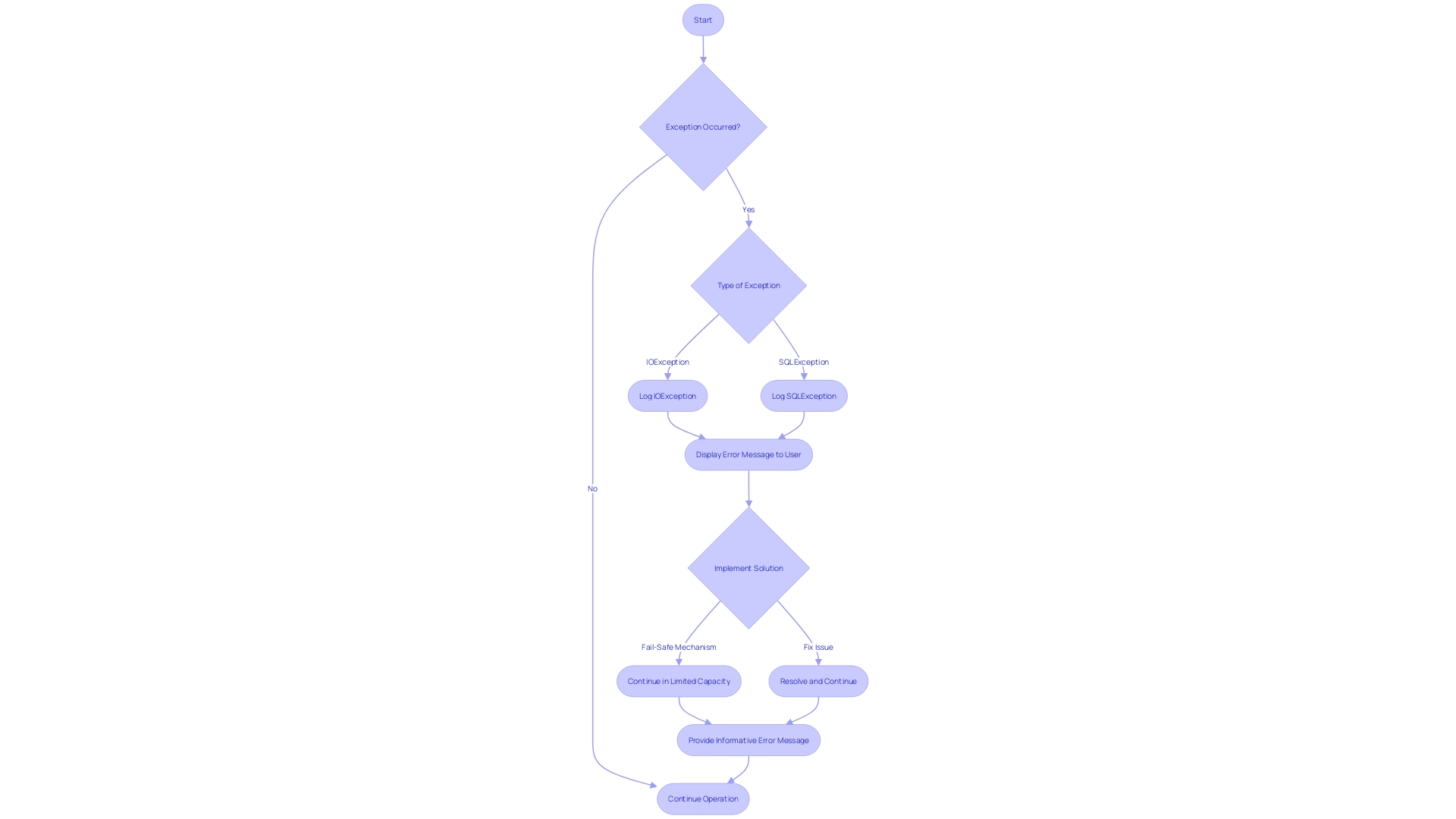Introduction
In the fast-paced world of software development, ensuring robust and reliable applications is paramount. Proper exception handling stands as a cornerstone for achieving this goal, particularly in Java applications. By effectively managing errors, developers can prevent unexpected crashes and maintain a seamless user experience.
This article delves into the importance of strategic exception handling, the benefits of catching specific exceptions, the critical role of logging, and the advantages of creating custom exceptions. Through real-world examples and insights, discover how adopting these practices can lead to more resilient, efficient, and user-friendly software systems.
Importance of Proper Exception Handling
Efficient error management is crucial for preserving the strength and dependability of Java applications. Effectively handling errors can avert unforeseen failures and guarantee a more seamless experience for the individual. For instance, in a distributed e-commerce system hosted on AWS, proper error handling across microservices such as user management, product catalog, ordering, and payment processing can significantly enhance the system's reliability. Using tools like Resilience4j to implement fault tolerance patterns, including circuit breakers and retries, developers can ensure that services remain resilient even under heavy load. This not only prevents significant downtime, especially during peak hours, but also boosts customer satisfaction and trust. Based on a research that included more than 750,000 accident reports and insights from 18 developers and team leaders, the accuracy in pinpointing faulty files through systematic methods was approximately 80%, underscoring the significance of efficient issue management in preserving system stability.

Catching Specific Exceptions
Managing specific exceptions enables developers to handle various types of issues with precision. For example, in a web application, handling IOException separately from SQLException allows for different responses, such as informing individuals about connectivity problems versus database issues. This approach not only helps in debugging but also improves the experience for individuals by providing relevant feedback. Based on a research project that included more than 750,000 accident records and insights from 18 developers, concentrating on particular types of issues greatly enhances the effectiveness of bug fixing. Efficient handling of issues is essential for preserving a reliable user experience, particularly in online applications. Adequate logging and reporting of problems enable developers to monitor issues in real-time, facilitating the identification and resolution of them swiftly. Recording issues to a server or dedicated service is crucial for this strategy. As pointed out by specialists, preventing a program from crashing abruptly and managing issues gracefully is essential in software development. This meticulous attention to detail in error management ultimately leads to a more resilient and user-friendly software.

Logging Exceptions Appropriately
Recording exceptions is a crucial activity that assists teams in tracking system health and identifying problems. For example, Swisslos, a gaming firm, encountered difficulties with the rising amount of logs from their web system firewalls and other essential systems. By implementing a strategy using Cribl Stream, they managed to handle rapid data growth while maintaining efficiency and cost-effectiveness. This logging method enabled them to automate deployment, load balancing, and scaling of containerized software, ensuring smooth operations. Furthermore, in the field of online commerce, programmers implementing a thorough logging structure recorded extensive stack traces and individual context for each error. This approach enabled quicker resolution of issues, improved software performance, and assisted in identifying and correcting recurring problems, ultimately enhancing the experience for individuals and operational efficiency.
Custom Exceptions for Better Error Handling
Developing personalized issues enables programmers to specify particular failure situations customized for their applications, improving both handling of problems and overall experience. For instance, in a library management system, a custom exception like BookNotAvailableException can clearly indicate when a book is unavailable. 'This not only provides more meaningful issue messages but also simplifies debugging for developers and enhances communication with users.'. According to software development practices, effective issue management is essential for preserving the reliability, robustness, and user-friendliness of programs. Custom exceptions play a significant role in achieving this by providing clear and concise issue information tailored to the application's context. This approach is supported by the principle of designing by contract, ensuring that the error conditions are well-defined and managed effectively.
Conclusion
In the realm of software development, particularly within Java applications, the significance of proper exception handling cannot be overstated. Effective management of exceptions serves as a foundational element for creating robust and reliable systems. By implementing strategic practices such as employing fault tolerance patterns and catching specific exceptions, developers can significantly enhance application stability and user satisfaction.
The demonstrated benefits, such as preventing unexpected crashes and improving customer trust, highlight the essential role of meticulous exception handling in today's fast-paced digital landscape.
Furthermore, the practice of logging exceptions appropriately emerges as a critical strategy for monitoring application health and diagnosing issues efficiently. By adopting comprehensive logging frameworks, teams can ensure that they are equipped to handle rapid data growth while maintaining operational efficiency. This proactive approach not only facilitates faster issue resolution but also contributes to improved application performance, ultimately leading to a seamless user experience.
The creation of custom exceptions further enriches the error handling process, allowing developers to define specific error conditions relevant to their applications. This tailored approach enhances communication with users and simplifies debugging, reinforcing the overall reliability and user-friendliness of software solutions. By embracing these best practices, developers can cultivate applications that are not only efficient but also resilient and responsive to user needs, paving the way for a more productive software development environment.
Frequently Asked Questions
Why is efficient error management important for Java applications?
Efficient error management is crucial as it helps preserve the strength and dependability of Java applications. Proper handling of errors can prevent unforeseen failures and ensure a smoother experience for users, especially in complex systems like distributed e-commerce.
How does error handling improve reliability in microservices?
In a distributed e-commerce system, effective error handling across microservices—such as user management, product catalog, ordering, and payment processing—significantly enhances system reliability. Utilizing tools like Resilience4j allows developers to implement fault tolerance patterns like circuit breakers and retries, which help maintain service resilience under heavy load.
What are the benefits of managing specific exceptions?
Managing specific exceptions allows developers to handle different types of issues with precision. For instance, distinguishing between IOException and SQLException enables tailored responses that improve user feedback and assist in debugging, ultimately enhancing the user experience.
How does logging contribute to efficient error management?
Adequate logging and reporting of problems are essential for real-time monitoring, enabling developers to identify and resolve issues quickly. This involves recording issues to a server or dedicated service, which helps in preventing abrupt program crashes and managing issues gracefully.
Can you provide an example of effective logging in practice?
An example is Swisslos, a gaming firm that faced challenges with increasing log volumes. By using Cribl Stream, they effectively managed rapid data growth while ensuring efficiency and cost-effectiveness. This logging strategy facilitated automated deployment and improved operational efficiency.
What is the role of custom exceptions in error management?
Custom exceptions allow developers to define specific failure situations tailored to their applications. For example, a BookNotAvailableException in a library management system clearly communicates when a book is unavailable, enhancing debugging and user communication.
What research supports the effectiveness of error management strategies?
Research involving over 750,000 accident reports and insights from 18 developers indicates that focusing on specific types of issues improves bug fixing effectiveness. Additionally, systematic methods for identifying faulty files achieved approximately 80% accuracy, highlighting the importance of efficient issue management.
How does effective issue management impact user experience?
Effective issue management is essential for maintaining a reliable user experience in online applications. By providing clear and concise error messages and ensuring quick resolutions, it leads to improved software performance and increased user trust.




